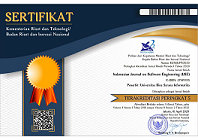Rancang Bangun Absensi Pegawai Harian Lepas Berbasis Intranet Pada Diskominfo Kab.Tegal Menggunakan Python
Abstract
Abstrak
Banyaknya indikasi kecurangan dalam melakukan absensi manual dengan cara tulis tangan bagi Pegawai Harian Lepas (PHL) memunculkan kebutuhan baru bagi organisasi yaitu menyediakan dan menyelenggarakan absensi digital guna menerapkan transformasi digital bagi Pemerintah Daerah khususnya Diskominfo Kab.tegal serta meningkatkan kedisiplinan pegawai non ASN. Dengan latar belakang kebutuhan organisasi tersebut, penelitian ini bertujuan untuk membuat rancang bangun absensi Pegawai Harian Lepas yang berbasis intranet menggunakan python sebagai bahasa pemrogramannya. Dengan adanya absensi berbasis intranet, maka diharapkan kedisiplinan pegawai dapat meningkat dan meningkatkan pula kinerja organisasi. Adapun metode yang digunakan adalah waterfall dengan tahapan pengumpulan data dan analisis kebutuhan, pembuatan Entity Relationship Diagram (ERD), Logical Record Structure (LRS) dan Use Case, perancangan antarmuka dan pembuatan program, serta rekayasa jaringan. Hasil dari penelitian ini adalah tersedianya aplikasi absensi untuk Pegawai Harian Lepas Diskominfo Kab.Tegal yang hanya dapat diakses dari jaringan intranet di area kerja menggunakan antar muka web dengan protokol https. Dari hasil penelitian, dapat disimpulkan bahwa aplikasi absensi berbasis intranet dapat memenuhi kebutuhan organisasi dan tujuan penelitian.
Kata kunci: absensi, pegawai, intranet, python
Abstract
The many indications of fraud in performing manual attendance by hand for Pegawai Harian Lepas (PHL) raise new needs for organizations, namely providing and organizing digital attendance to implement digital transformation for Regional Governments, especially Diskominfo Kab. Tegal and improve the discipline of non-ASN employees. With the organization's needs background, this study aims to design an intranet-based freelance daily employee attendance design using Python as the programming language. With intranet-based attendance, it is expected that employee discipline can increase and improve organizational performance. The methods used waterfall with steps include data collection and requirements analysis, entity-Relationship Diagrams, Logical Record Structures, Use Cases, interface design and programming, and network engineering. The result of this study is the availability of an attendance application for Pegawai Harian Lepas of Diskominfo Kab. Tegal can only be accessed from the intranet network in the work area using a web interface with the HTTPS protocol. The study results concluded that the intranet-based attendance application could meet organizational needs and research objectives.
Keywords: attendance, employee, intranet, python
Full Text:
PDFReferences
Avgerou, C., Hayes, N., & la Rovere, R. L. (2016). Growth in ICT uptake in developing countries: New users, new uses, new challenges. In Journal of Information Technology (Vol. 31, Issue 4, pp. 329–333). Palgrave Macmillan Ltd. https://doi.org/10.1057/s41265-016-0022-6
Bhatt, Y., & Pahade, P. (2021). Application of Python Programming and Its Future (pp. 849–857). https://doi.org/10.1007/978-981-16-0882-7_76
Curwen, P., & Whalley, J. (2021). Private Networks. Digital Policy, Regulation and Governance, 23(4), 432–434. https://doi.org/10.1108/DPRG-06-2021-181
Foster, E. (2021). User Interface Design (pp. 237–254). https://doi.org/10.1201/9780367746025-17
Garcia-Murillo, M. (2013). Does a government web presence reduce perceptions of corruption? Information Technology for Development, 19(2), 151–175. https://doi.org/10.1080/02681102.2012.751574
Glyptis, L., Christofi, M., Vrontis, D., Giudice, M. del, Dimitriou, S., & Michael, P. (2020). E-Government implementation challenges in small countries: The project manager’s perspective. Technological Forecasting and Social Change, 152(September 2019).
Haenssgen, M. (2019). Data Collection Methods (pp. 25–51). https://doi.org/10.1108/978-1-83909-229-920191004
Lafta, A. (2018). Data collection methodes. https://doi.org/10.13140/RG.2.2.23746.43205
Larson, J., & Larson, C. (2021). Well-Formed Entity Relationship Diagrams (pp. 127–142). https://doi.org/10.1201/9780429114878-14
Loftus, S. C. (2022). Chapter 3 - Data collection: methods and concerns. In S. C. Loftus (Ed.), Basic Statistics with R (pp. 17–25). Academic Press. https://doi.org/https://doi.org/10.1016/B978-0-12-820788-8.00013-4
Murti, K. C. S. (2022). Use Cases (pp. 21–34). https://doi.org/10.1007/978-981-16-3293-8_2
Pamungkas, A., Nugroho, L., & Sulistyo, S. (2020). EVALUASI FAKTOR KEGAGALAN SISTEM INFORMASI PADA KESIAPAN PENERAPAN E-GOVERNMENT: STUDI LITERATUR. JIKO (Jurnal Informatika Dan Komputer), 3, 143–152. https://doi.org/10.33387/jiko.v3i3.2176
Peraturan Bupati Tegal Nomor 12 tahun 2016 tentang Presensi Elektronik Bagi Pegawai Negeri Sipil Di Lingkungan Pemerintah Kabupaten Tegal, (2016).
Salehi Fathabadi, A., Snook, C., Hoang, T. S., Dghaym, D., & Butler, M. (2021). Refinable Record Structures in Formal Methods (pp. 3–15). https://doi.org/10.1007/978-3-030-87657-9_1
Verhoef, P. C., Broekhuizen, T., Bart, Y., Bhattacharya, A., Qi Dong, J., Fabian, N., & Haenlein, M. (2021). Digital transformation: A multidisciplinary reflection and research agenda. Journal of Business Research, 122, 889–901. https://doi.org/10.1016/j.jbusres.2019.09.022
DOI: https://doi.org/10.31294/ijse.v8i1.12159

This work is licensed under a Creative Commons Attribution-NonCommercial-ShareAlike 4.0 International License.
ISSN : 2714-9935


Published by LPPM Universitas Bina Sarana Informatika
Jl. Kramat Raya No.98, Kwitang, Kec. Senen, Kota Jakarta Pusat, DKI Jakarta 10450
This work is licensed under a Creative Commons Attribution-ShareAlike 4.0 International License









